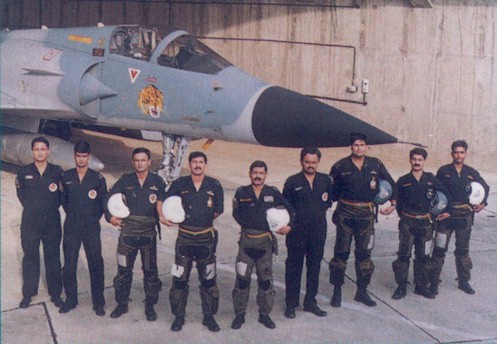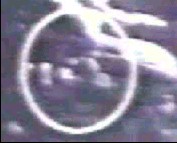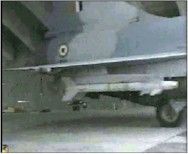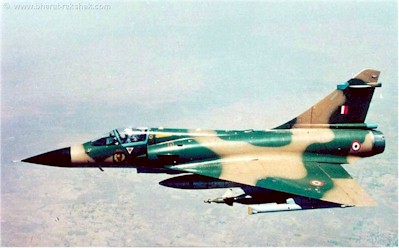
The Mirage 2000 , seen here carrying a Remora EW Pod and a Paveway LGB.
The mild winter in Jammu and Kashmir during 1998 enabled Pakistani Army Regulars and Mercenaries to infiltrate, and set up camps on the Indian Side of the Line of Control (L-O-C). The build of forces, unknown to Indian Authorities at the time was to have a major impact on the Indian Air Force (IAF) the following year as it fought to dislodge the enemy.
The battle was to take place over some of the highest terrain in the world, where aircraft and weapons were limited in their effectiveness. Conventional targets like airfields, command and control centre and convoys did not exist. Instead the IAF were to be confronted with tents and fortified bunkers, the single biggest structure being a hangar capable of taking a helicopter. The advance along the LOC was eventually to penetrate up to 10 kms in some areas along a line 200 kms long. All the ridges in the area were off shoots of K2 (8611 metres); the world’s second tallest mountain or Nanga Parbat (8126 metres); both located on the Pakistan side. Because of the climatic conditions and wind directions, a large number of features are shear cliffs on the Indian Side with gradual gradients on the other. Heights varied along the line, with a low of 2700 metres at Kargil, going up to 3400 metres in Dras and Tiger Hill being at 5000 metres. The area had no habitation and was covered in snow for most of the year. Strategically the area could not be used as a launch pad for a major offensive, its sole importance being the heights and the threat to National Highway 1A.
The IAF were limited in what they could use at such a demanding altitude. Attack helicopters were initially preferred with Mil-17’s being employed. However due to the abundance of man portable SAM’s, such as the Stingers, their effective operation was not possible due to the hostile flying environment. Therefore the IAF decided after experience that high altitude bombing by fighter aircraft and in particular the Mirage 2000, was the best option.
To fully understand the role played by the Mirage 2000 during ‘Operation Vijay’ and the sterling work performed by pilots and support staff; we need to go back in time. The IAF ordered 42 single seat and 7 dual seat Mirage 2000 aircraft, that were delivered starting in 1985. Two squadrons, numbers 1 ‘Tigers’ and 7 ‘Battleaxes’, at Gwalior, operate the fleet. For 14 years they have been highly regarded in the IAF, being a stable weapons platform and having a good safety record. The Kargil Conflict was to push that high esteem to even greater heights.
The Tigers at War: Kargil gave the opportunities for various IAF units to send in their best. Seen in this image is a Mirage 2000H, from the No.1 Tigers Squadron.
The Mirage 2000 were supplied with Thomson-CSF Laser Designator Pod, known as ‘ATLIS’ which was capable of delivery of Matra 1000 kg LGBs, which were purpose built for destruction of reinforced targets. These weapons were highly capable but were very expensive. It was decided to augment their capability by adding the 1000 lb bomb coupled with Paveway II laser-guided bomb kit. The IAF had ordered a number of these, but they had been supplied with an incorrect part. Because of the nuclear test performed by India, they were on the embargo list and were unable to get the correct parts sent as replacements. Consequently IAF technicians had to remanufacture this part in order to make the Paveway serviceable for use on the Mirage.
Another event was to take place during May that was to have a major impact on the work going on at Gwalior. On the 9th May, Pakistani Shelling along the Line of Control intensified and appeared to be more accurate in it’s spread. This began to threaten the strategically important National Highway 1A, which ran from Srinagar to Leh, and which was only open from May until October because of the weather. It became apparent that artillery spotters were entrenched along the peaks on the Indian Side of the L-O-C. Initially the Indian Army suffered badly due to the terrain and having to attack well dug in defenders up the high peaks. The Army Chief on the 26th formally requested IAF Support after losses had started racking up to un-acceptable levels.
The IAF had up until that time only flown photo-recon missions. This had resulted in a Canberra from 106 squadron being hit by a Stinger Missile on the 21st whilst over Batalik. Luckily the aircraft was able to make a safe recovery to Srinagar and PR missions were subsequently flown at higher altitude by Mig25RBT’s from 102 squadron.
Following the commitment of combat resources by the IAF, initial operations involved low level air strikes in the Tololing Sector using Mil-17’s and fighters, such as the MiG-21, 23 and 27. Strikes using these jet fighters were to continue throughout the duration of the war. During these operations two fighters were lost on the 27th May and one Mil 17 was lost on the 28th. The loss of the Mil 17 and its four crew proved to be a turning point in IAF thinking. The aircraft was on standby for an attack mission to Tololing and did not have adequate self-protection in the form of chaff and flares. However a helicopter with protection aborted its mission and as a result 4 crew were killed when the Mil-17 was attacked by 3 Stingers. Immediately the IAF decided to re-assess the situation. Of the attack helicopters only the Mil-17 could operate at this altitude, the Mil-35 could not. However the environment was awash with man portable SAM’s and deemed too hostile to commit further helicopter resources. Planners at IAF HQ began to re-think their offensive strategy. They thought about committing the Mirage 2000 to the conflict to augment the other jet fighters. This aircraft could operate at this altitude with no problem, but it had no high altitude attack capability.
On the 30th May, IAF HQ decided to commit the aircraft, which had already moved to forward operating location in their air defence role, to the offensive. Now the work of the back room staff and pilots was to intensify greatly. The status as of early June was that aircraft, pilots and technicians were spread around at Western Air Command bases and Gwalior. The Mirage 2000 aircraft itself had always been regarded as an air defence fighter with a limited ground attack capability. Consequently it lacked certain resources such as bombs, hardpoint pylons, tooling, testers and ground crew experience in such matters. A big push was instigated at Gwalior to get the platform prepared. By the 12th June, the IAF Personnel had ironed out most of the faults.
Enough equipment was found to make twelve aircraft at any given time, capable of delivering bombs. However bombs were not readily available to suit, so a search was made of the IAF Inventory. Vintage 250kg bombs from the 1970’s that were made in Spain for the HAL Ajeet aircraft and had been in storage were found and made available. A one off trial was carried out from Jaisalmer over the Porkoran Range on the 1st June and was deemed to be successful. They were immediately rushed into service with the Mirages of 7 Squadron. Initial missions were flown using dumb bombs only. Each aircraft would be configured with 12 bombs, 1 ventral fuel tank and 2 ‘MAGIC-2’ Air to Air Missiles. The mission would depart and meet up with fighter escorts from 1 Squadron, and then fly into the Indian Side of Jammu and Kashmir, with Mig29’s operating as top cover. The attacks took place initially on Point 5140 near Tololing in the Dras Sector and 4 strikes took place over 3 days. The Indian Army re-took this position on the 20th June after fighting in tandem with continuous IAF Strikes.
Notable amongst 7 Squadrons approximate 200 plus attack missions were the airstrikes on Muntho Dhalo, Tiger Hill and Point 4388 in the Drass Sector. On the 16th June, the major enemy supply depot at Muntho Dhalo in the Batalik Sector was sighted by a Mirage on the LDP. The following day this was hit and destroyed by aircraft from 7 Squadron using dumb bombs. This camp was the major re-supply base in the Batalik Sector and this devastating attack left over 100 dead and 50 structures destroyed.
On June 24th, the Enemy Battalion HQ on Tiger Hill top was hit by two Mirage 2000 employing the ‘PAVEWAY’ Laser Guided Bomb (LGB). This was the first operational use on an LGB by the IAF. In another mission on the same day Mirages stuck the same target using dumb bombs. This strike proved to be particularly effective causing severe damage to the enemy. It also gave Indian Army Troops watching from nearby a tremendous morale boost. This mission was witnessed by ACM Tipnis, then officer commanding IAF, who was flying backseat in a another Mirage 2000TH. An IAF spokesperson said at a press conference on the 25th that, ‘ New weapons delivery techniques had been developed by Western Air Command, that had proved very accurate and had caused considerable damage to the enemy positions. They had been effective in achieving the desired results.’ Attacks continued on Tiger Hill, which was heavily defended with man portable Stinger Missiles for several days, during the day and night. After continuous air attacks, the Indian Army recaptured Tiger Hill on the 4th July after an 11-hour night battle.
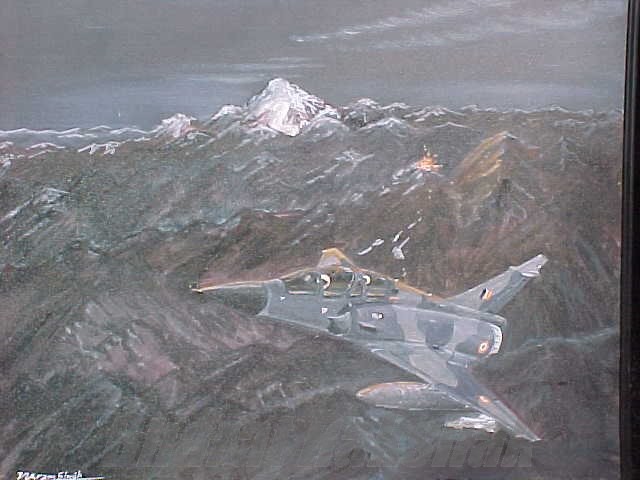
On the 4th July a strike with dumb bombs was made for the first time on gun positions and a supply camp at Point 4388 in the Dras Sector. These attacks proved to be highly successful and culminated in a serious degradation of the enemy supply chain. The series of attacks on Point 4388 was an excellent example of how lethal airstrikes combined with good recon detected the enemy plans to shift to alternative supply routes, which were then attacked strangling their supply arteries. Follow up attacks were made by Mirages on the 6th July, four aircraft dropping twenty four dumb bombs and on the 10th July, three aircraft dropping fifteen dumb bombs. These attacks broke the enemy resistance and because of the high casualty rate amongst officers, seriously degraded their command and control leading to the overrunning of their position by the Indian Army. In fact by the 9th July the Indian Army had recaptured 99% of the Batalik Sector and 90% of the Dras Sector.
A typical bombing mission would involve 4 Mirages from 7 Squadron loaded with dumb bombs leaving a base in Punjab together with a two seat Mirage loaded with a LGB and Laser Designating pod. This 5 ship would rendezvous with 3 aircraft of 1 Squadron carrying Beyond Visual Range Weapons (Super 530D), operating out of another base. This rendezvous point would change on a mission to mission basis and once joined up, one escort aircraft would return. Once over Jammu and Kashmir they would be joined by Mig29’s giving top cover. These only had 20-minute duration in the area and would usually be supplemented by another pair. Over the target the Mirages with the dumb bombs would visually acquire the target and drop their bombs. The two seater, which would be filming the whole affair from behind, would only use the LGB if required to do so. Only 9 LGB’s were dropped during the whole war, 8 by the Mirage fleet and one by a Jaguar. Normal procedure employed during the dumb bomb attacks was for the aircraft to commence a dive at about 30,000 feet and designate the target at 15 kms distance. At 8 kms distance anything from 6 to 12 bombs would be despatched towards the target. Procedure for a LGB attack would differ in that the target would be acquired at 20 kms distance, designation would occur at 15 kms with release of the weapon at 8.5 kms. The LGB would travel towards the target and the Mirage would turn away still illuminating the target and at point of impact it would be 6 kms away.
Several IAF personnel from Gwalior received decorations following the war. The commanding officer of 7 Squadron, Wing Commander Sandeep Chhabra received the Yudh Sena Medal, as did the commander of 1 Squadron, Wing Commander S. Neelakantan. Wing Commander R. Nambiar received the Vayu Sena Medal, as did fellow 7 Squadron pilots, Squadron Leaders M Rao, D.K Patnaik and Flt Lt Tokekar. The technical officer of 1 Squadron, Squadron Leader K. Ravi, received the Vayu Sena Medal for his work in adapting bombs for use on the Mirage 2000. Two pilots from 1 Squadron (Sqn Ldr S Jha & Wani) and one from 7 Squadron (Flt Lt M Yadav) received ‘Mentions in Despatches’.
During the whole of ‘Operation Vijay’, the total of jet fighter sorties came to 1199, of which the Mirage fleet had flown over 500. 1 Squadron flew 274 operational sorties The majority of missions flown consisted of air defence and strike escorts missions. 7 Squadron had completed over 240 strike missions during the same period dropping over 55,000 Kgs of ordnance.
The IAF had successfully completed the following achievements,
1. Established a no fly zone over the target area for enemy airpower.
2. Attacked Point 5140.
3. Located and destroyed Muntho Dhalo.
4. Hit targets on Tiger Hill on several occasions.
5. Hit Point 4388.
The key to the Mirages success was being able to reach its operating altitude and hitting the target with LGB’s and conventional weapons, twenty-four hours a day.
